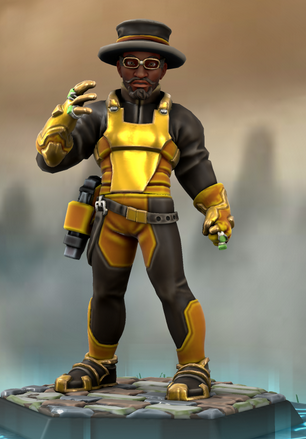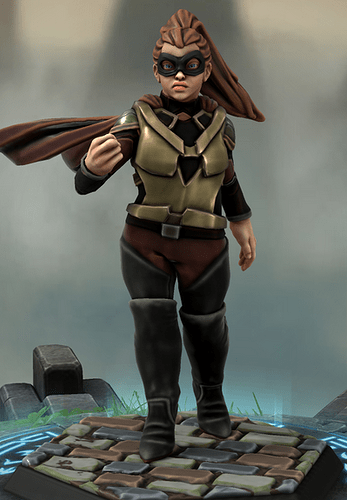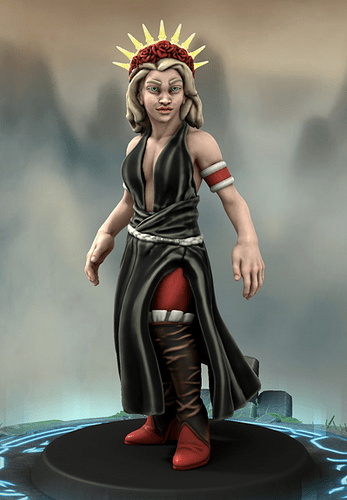Randomizers:
Approach: 3, 1, 7 [Options: Relentless, Underpowered, Bully, Focused, Mastermind, Overpowered]
Archetype: 8, 1, 4 [Options: Predator, Guerilla, Formidable, Inhibitor, Loner, Legion]
Upgrade: 4, 7, 10 [Options: Villainous Vehicle, Quality Upgrade I, Calming Aura]
Mastery: 2, 1, 8 [Options: Behind the Curtain, Mad Science, Profitability]
Witchfinder

Real Name: Caleb Bickerton, First Appearance: Veilwalkers #12, Feb 2020
Approach: Mastermind, Archetype: Inhibitor
Upgrade: Quality Upgrade I, Mastery: Mad Science
Status Dice: Based on heroes with penalties. 3+: d10. 1-2: d8. None: d6. Health: 30+5H (Upgraded 50+5H)
Qualities: Ranged Combat d10, Stealth d8, Science d8, Magical Lore d8, Investigation d8, Revenge Is Best Served Hot d8
Powers: Lightning Calculator d12, Fire d10, Speed d8
Abilities:
- Anti-Magic Adjustments [A]: Boost yourself using Science and use your Max die. Either make that bonus persistent and exclusive, or Boost yourself again using your Min+Mid dice.
- Backdraft [A]: Attack one hero using Fire. Hinder all heroes using your Max die.
- Widdershins [A]: Select a nearby target. Either turn all bonuses on that target to equivalent penalties, or move a penalty from that target to another target that you can see.
- The Beast Burns [R]: When Attacked by someone with a penalty you created, Defend by rolling your single status die, and the attacker also suffers that much damage.
- (U) The Family Genius (I): Increase your Ranged Combat to d12, and your Stealth, Science, Magical Lore, and Investigation to d10.
- (U) Master of Mad Science (I): As long as you have access to materials, you can automatically succeed when Overcoming a challenge by using scientific principles and inventions.
Common Scene Elements:
- Bickerton Security. d8 Minions. If any other minions or lieutenants are nearby, this minion has a +1 to their actions. If not, they have a -1 to their actions.
- Anti-Magic Devices. This complex challenge gradually weakens the magical powers of heroes until found and disabled.
- A Heavily Trapped Environment, which will mostly unleash Attacks and Hinders against unprepared targets. The Witchfinder does not hunt unprepared.
While the Veilwalkers worked to deal with the problems created by the world’s new leylines, they were not the only people affected, nor the only people looking for answers. Unfortunately, one of the other groups involved was far less devoted to the good of the common person.
Bickerton Security, despite its name, was not controlled by the dwindling Bickerton family. Their dwindling fortunes and numerous setbacks at the hands of their ongoing feud with Lostwood ultimately led the company to be purchased by their rivals, and while a handful of extended family members continued to work there, the agency was a shell of its former self, hiring out tech-empowered security officers to celebrities or politicians terrified of the threat of super-powered individuals. When a new series of magical events threatened some of their clients, however, one of Bickerton’s top researchers saw an opportunity.
Caleb Bickerton was a descendant of the Bickerton family, albeit one whose grandfather had married against the family’s wishes and who had been raised without access to the shrinking family fortune. He was also a genius, devoting his life to the studies of extradimensional phenomena. In the new ley line eruptions, he saw a chance to gain revenge both on the main family branch for shunning his parents, and against the magical creatures that he held responsible for humanity’s sorrows. He began work on a new line of Bickerton security products, testing them in person and violently closing ley lines. The backlash would echo through the lines, affecting people elsewhere, but that just meant more customers in the future. Caleb became known as the Witchfinder, a man with an unerring ability to seek out magical forces, outfitted with genetic upgrades that let him vent his own adrenaline as flames, enhanced by scientific formulas to be particularly harmful to magical forces.
In Veilwalkers #12, a Bickerton Security contract led Witchfinder directly into conflict with the Veilwalkers, as they tried to solve a fractured leyline that he was simultaneously trying to detonate. The resulting battle was the first major setback for Caleb, with Veilweaver undoing his forces, Harbinger chasing off his men, and Adamant and Eli confronting him directly and forcing him to retreat. Swearing vengeance, Witchfinder set about learning the full details of his enemies’ magic, planning to return with carefully-crafted counters to each of their abilities…
Behind the Scenes
We haven’t seen the Bickertons since the 70s, although they’ve probably been around a little bit here and there as background elements or as minor Twilight Carnival villains. I like the idea that they had mostly faded away, until someone wanted a new threat and grabbed a classic enemy of Lostwood to bring back!
Witchfinder is a fairly standard villain, a scientific mastermind who weakens enemies to let his minions pile on them and who has nasty tricks if people come at him anyway. His Widdershins is pretty nasty against the Veilwalkers, who tend to stack up bonuses, but otherwise he’s mostly doing normal things and acting as a distraction for his challenges and minions.



